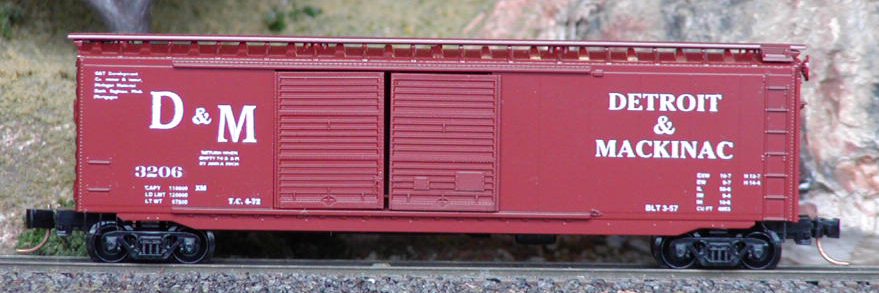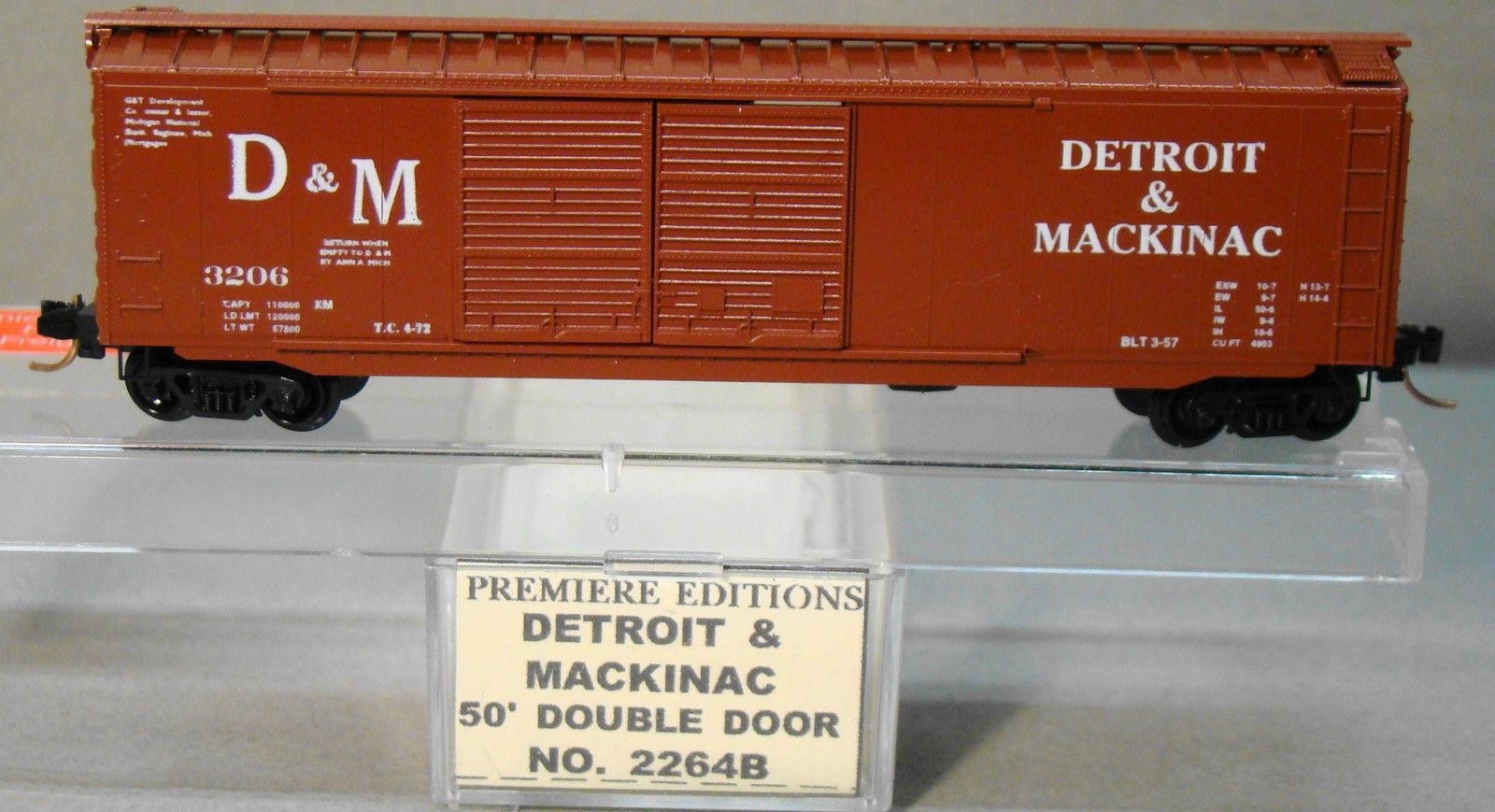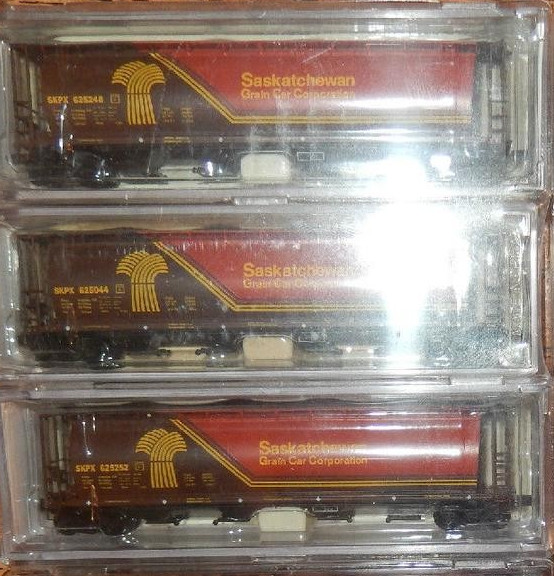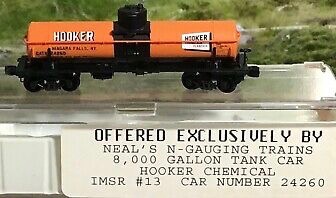Specific Item Information: Road numbers announced on the former The Freight Yard website for this series:
- 2264A: D&M 3206 --> reassigned to 2264B
- 2264B: D&M 3209 --> reassigned to 2264C
- 2264C: D&M 3212 --> not found, don't know the road number assigned to 2264A
- 2264A: D&M 3206 --> reassigned to 2264B
- 2264B: D&M 3209 --> reassigned to 2264C
- 2264C: D&M 3212 --> not found, don't know the road number assigned to 2264A
Model Information: Although not specifically marketed as such, this body style has been used to model 50 foot PS-1 Boxcars.
Prototype History: The 50-foot boxcar made its first appearance in the 1930s and steadily grew in popularity over the years, which further improved redundancies by allowing for even more space within a given car. Today, the 50-footer remains the common boxcar size. After the second world war ended, and steel became once again readily available, steel became the go-to choice for construction of boxcars. Pullman Standard and ACF were some of the most prolific builders of these cars.
Double Doors were frequently an option for most of the major North American railcar manufacturers in the 1950s, 1960s and 1970s. These cars were slightly more expensive to produce and maintain, but for many applications allowed faster loading and unloading times.
Double Doors were frequently an option for most of the major North American railcar manufacturers in the 1950s, 1960s and 1970s. These cars were slightly more expensive to produce and maintain, but for many applications allowed faster loading and unloading times.
Road Name History: 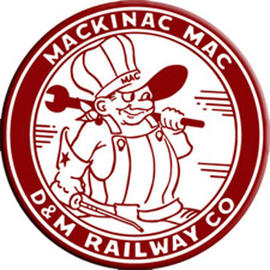 First of all, Mackinac is pronounced “MACKinaw.” The Mackinac region is where Lake Superior and Lake Huron meet. Some towns in the region spell it with a W but not the D&M.
First of all, Mackinac is pronounced “MACKinaw.” The Mackinac region is where Lake Superior and Lake Huron meet. Some towns in the region spell it with a W but not the D&M.
The D&M was established in 1894 as part of the reorganization of the Detroit Bay City & Alpena Railroad. The D&M ran from Cheboygan to Bay City and La Rocque plus branches, all in Michigan’s lower peninsula. The total mileage was 348, making it nearly as big as cross-lake neighbor Duluth Missabe & Iron Range. D&M had picked up some former Penn Central lines excluded from Conrail but service ended in 1990 on those routes. Traffic was primarily forest products and aggregates. In addition to connections on the southern end of the D&M, they interchanged with the Duluth South Shore & Atlantic (later SOO) on the Upper Peninsula via car ferry from Bay City across the Straights of Mackinac.
D&M’s diesel roster (around 12 units) was almost entirely Alco. They also had about 1200 freight cars. Their logo had a cartoon of an engineer named Mackinac Mac holding a wrench. The Detroit & Mackinac flag fell in 1992 when the owners sold it to a new railroad, Lake State Railway.

The D&M was established in 1894 as part of the reorganization of the Detroit Bay City & Alpena Railroad. The D&M ran from Cheboygan to Bay City and La Rocque plus branches, all in Michigan’s lower peninsula. The total mileage was 348, making it nearly as big as cross-lake neighbor Duluth Missabe & Iron Range. D&M had picked up some former Penn Central lines excluded from Conrail but service ended in 1990 on those routes. Traffic was primarily forest products and aggregates. In addition to connections on the southern end of the D&M, they interchanged with the Duluth South Shore & Atlantic (later SOO) on the Upper Peninsula via car ferry from Bay City across the Straights of Mackinac.
D&M’s diesel roster (around 12 units) was almost entirely Alco. They also had about 1200 freight cars. Their logo had a cartoon of an engineer named Mackinac Mac holding a wrench. The Detroit & Mackinac flag fell in 1992 when the owners sold it to a new railroad, Lake State Railway.
Brand/Importer Information: The Freight Yard was a hobby shop that did custom decoration and special runs of other manufacturers' N Scale products. It sold its custom products under several brands or collections: Premiere Editions, by The Freight Yard and Dreams Design.
It was located in Anaheim, California and then moved to 2006 in Phoenix, Arizona.
Established in the late 1980s, it stopped business under this name by the end of the 2000s.
The Freight Yard was owned and operated by Darren J. Cohen. Darren is now operating North Valley Trains.
The Freight Yard / Premiere Editions runs are usually available in series of two to twelve different numbers (suffixed A to M, with I not used).
The first two digits of the stock number correspond to the release year (9x being 199x, and 2x being 200x).
It was located in Anaheim, California and then moved to 2006 in Phoenix, Arizona.
Established in the late 1980s, it stopped business under this name by the end of the 2000s.
The Freight Yard was owned and operated by Darren J. Cohen. Darren is now operating North Valley Trains.
The Freight Yard / Premiere Editions runs are usually available in series of two to twelve different numbers (suffixed A to M, with I not used).
The first two digits of the stock number correspond to the release year (9x being 199x, and 2x being 200x).
Manufacturer Information:  Micro-Trains Line split off from Kadee Quality Products in 1990. Kadee Quality Products originally got involved in N-Scale by producing a scaled-down version of their successful HO Magne-Matic knuckle coupler system. This coupler was superior to the ubiquitous 'Rapido' style coupler due to two primary factors: superior realistic appearance and the ability to automatically uncouple when stopped over a magnet embedded in a section of track. The success of these couplers in N-Scale quickly translated to the production of trucks, wheels and in 1972 a release of ready-to-run box cars.
Micro-Trains Line split off from Kadee Quality Products in 1990. Kadee Quality Products originally got involved in N-Scale by producing a scaled-down version of their successful HO Magne-Matic knuckle coupler system. This coupler was superior to the ubiquitous 'Rapido' style coupler due to two primary factors: superior realistic appearance and the ability to automatically uncouple when stopped over a magnet embedded in a section of track. The success of these couplers in N-Scale quickly translated to the production of trucks, wheels and in 1972 a release of ready-to-run box cars.
Micro-Trains Line Co. split off from Kadee in 1990 to form a completely independent company. For this reason, products from this company can appear with labels from both enterprises. Due to the nature of production idiosyncrasies and various random factors, the rolling stock from Micro-Trains can have all sorts of interesting variations in both their packaging as well as the products themselves. When acquiring an MTL product it is very important to understand these important production variations that can greatly enhance (or decrease) the value of your purchase.
Please consult our Micro-Trains Collector's Guide

Micro-Trains Line Co. split off from Kadee in 1990 to form a completely independent company. For this reason, products from this company can appear with labels from both enterprises. Due to the nature of production idiosyncrasies and various random factors, the rolling stock from Micro-Trains can have all sorts of interesting variations in both their packaging as well as the products themselves. When acquiring an MTL product it is very important to understand these important production variations that can greatly enhance (or decrease) the value of your purchase.
Please consult our Micro-Trains Collector's Guide
Item created by: Alain LM on 2022-10-07 08:29:58. Last edited by Alain LM on 2022-10-07 08:32:17
If you see errors or missing data in this entry, please feel free to log in and edit it. Anyone with a Gmail account can log in instantly.
If you see errors or missing data in this entry, please feel free to log in and edit it. Anyone with a Gmail account can log in instantly.


